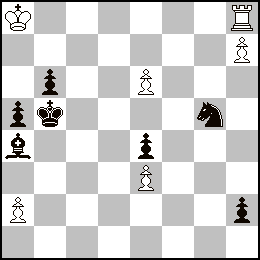A study composed at the time by a kid. Let the careless reader not stop on the way to a possible Rh7, the Ns are still alive because they still move! (bravo, you found the verb to move).
For my part, I like this study very much because an "archaic" theme of the finale is revisited with happiness.
Finally a more complex study (to transcribe without error as well as to search).

W (6) : Ka8, Rh8, Ph7,e6,e3,a2. B (7) : Kb5, Ba4, Ng5, Pa5,b6,e4,h2. White to play and draw.
(Very) nice study. Findable. But very difficult for a study to be solved in an indoor competition, as it was given in an indoor solving tournament in Warsaw.
Since I am supposed to provide the minutes of the meeting, here are two asides that were made at the time:
** The seriousness of the Polish organisers is to be commended, as in this competition they were able to propose a study, admittedly difficult, but very clear and correct, whereas the rule, or more exactly the current practice, is to propose demolished or even incomprehensible studies.
** Reminder from our friend Jacques on the expression "Falling from Charybdis into Scylla". For the Greeks, Charybdis and Scylla symbolised respectively the tides and the reefs of the Strait of Messina (which shows that sardines have been fished there for a long time). Two dangers threatened the sailors: a whirlpool and a reef, which would have been personified by the two monsters. It is therefore a question of running aground on the breakers while trying to escape the whirlpool. This maritime precision is dedicated to the titular greffier.
Then we move on to the game of the day.
Grichuk - Gelfand. 2002.
1:e4 e5; 2:Nf3 Nf6; 3:Ne5 d6; 4:Nf3 Ne4; 5:d4 d5; 6:Bd3 Bd6; 7:o-o o-o (Who is ahead, the Ws or the Bs? The answer depends on whether one judges Ne4 to be a strength or whether it would be better on f6?).
8:c4 c6; 9:Qc2 Na6;10:a3 (10:Be4 de; 11:Qe4 Re8; 12:Qc2 Nb4; 13:Qb3 Bf5; 14:Na3 Re2 and for sure the B's are not worse). 10:..f5; 11:Nc3 Nc7; 12:Re1 Kh8; 13:b4 Bd7; 14:Bb2 Ne6; 15:cd cd; 16:Nd5 Rc8; 17:Qd1 N6g5; 18:Ne5 (Here Gelfand analyses 18:Ne3 Nf3; 19:Qf3 Qh4; 20:g3 Qh6; 21:Qg2 Nf2; 22:Qf2 f4; 23:gf Rf4; 24:Qg2 Rcf8; 25:d5! but the audience, which is usually dissipated because it relies blindly on the master greffier to get out his claws as soon as a combination appears, felt an obligation of vigilance. Guy therefore proposed the improvement 24:...Bh3! instead of Rcf8 which completely restarts the machine at the moment when one thought the matter was settled. The ensuing complications are exciting, seeming to favour the B, but the master will certainly address the question in his electronic supplement.).
18:Ne5 Nh3; 19:gh Qg5; 20:Kf1 (20:Ng4? Nxf2 !) 20:..Bxe5; 21:de Bc6; 22:Bc1 Qh4; 23:Be4 fe; 24:Be3 Qh3; 25:Kg1 (25:Ke2? Bb5; 26:Kd2 Rf2; 27:Bf3 Qd3#) 25:..Bxd5; 26:Qd5 Qg4; 27:Kf1 Qh3; 28:Kg1 Qg4 draw agreed (28:...Rc6?; 29:Bf4 !).
At the table, the Loire wine being better than the usual Côtes du Rhone (in the opinion of the substitute greffier) I did not note the problems presented by Guy, less prolific than usual because he was (very) busy elsewhere. Nevertheless, he had enough to regale us.
The master gratified us with a helped selfmate 3 moves (in homage to Guy, first world producer in the discipline) in Mirror Circe as we say in these people, and in Evil Circé as we say here.

W(6): Ka2 Bf6 Pa3,d7,f5,g7
B(5): Kh6 Pb6,g2,h5,h7.
Erich Bartel. HS#3. Mirror Circe.
Finally, for those who are interested in one of Rémy's other activities, this is the first link to the Bouvet rames Guyane
https://www.youtube.com/watch?v=7Os5Ws6-a4k
and this link to see him working on the preparation of the ship
https://www.youtube.com/watch?v=paaM9fjtlFY
The electronic report of the Master will be sent to you later.
Kind regards,
O, Rhesus positive (for a change).
The substitute greffier.
Add a comment